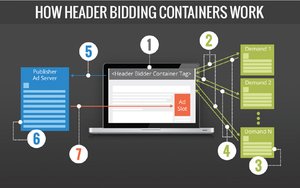
Digital media provider CPXi and bRealTime, the company’s programmatic division, on Tuesday released a white paper entitled
“Header Bidding Containers.”Header bidding involves advanced bidding ahead of the auction, when publishers offer all inventory
to multiple ad exchanges simultaneously before making calls to their ad servers.
Container solutions are a technology advancement that is an outgrowth of header bidding.
“A a lot
of different companies are putting out information on header bidding. A lot of them have touched on containers and wrappers, a piece of technology publishers integrate on their site that enables the
publisher to thread multiple demand sources through a single header integration. So instead of having up to 10 separate integrations, which slows down site speed, the container technology
allows publishers to thread all the demand sources through to one integration on their site,” said Johanna Pesso, VP of product for CPXi.
advertisement
advertisement
“We’ve had a lot of conversations
with our own clients and everyone’s confused, they don’t know what the right choice is,” Pesso said. “We wanted to provide information to help publishers to weigh the pros and
cons of the strategies available to them.”
One of the most interesting parts of the report focuses on the pros and cons of the different types of integrations. For example, some
publishers are developing technology in-house. Typically, it’s usually larger publishers that have a lot of resources. They have ad operations teams and the capacity to build, optimize and
maintain container technology because it’s so complex.
Other publishers use ad-tech vendors to hand-hold publishers through the entire process, which often leads to strong results.
Unsurprisingly, bRealTime promotes the idea of using a third-party tech vendor to do header bidding.
The white paper identifies best practices for choosing a partner. Three of the most
important ones:
1. Identify internal resources and what’s needed from a support standpoint. Can the partner selected provide the support needed?
2. Know what the vendor is
developing to help understand the bid landscape. Make sure the vendor is looking to the future and how it will leverage developments and trends in the bid landscape.
3. Make sure the selected
partner is bringing something unique to the table such as data on who’s bidding, who’s winning, who’s losing, where the incremental value and demand are coming from, win rates and
factors driving incremental lift in CPMs.
“These pieces of information will enable business operations to make decisions on which demand partners are valuable and which aren’t as
valuable,” said Brian Weigel, GM, bRealTime.
Weigel noted that the container solution should ensure that publishers can integrate everything effectively and all third-party demand
partners. This is so publishers can generate the most competition, to result in the highest yield. Publishers need to clearly see which demand sources are performing the best through data that can be
accessed through the ad server. The right tech vendor can provide more detail on things like time-out rates, average eCPMs, which placement the demand source is bidding the most on, fill rates and
more.